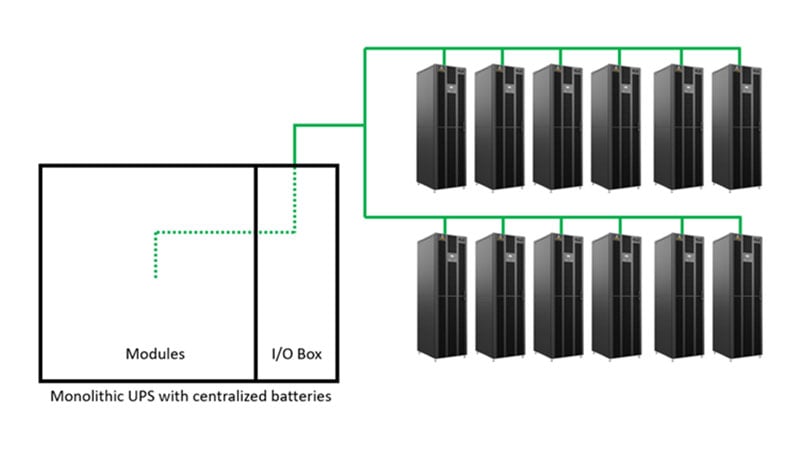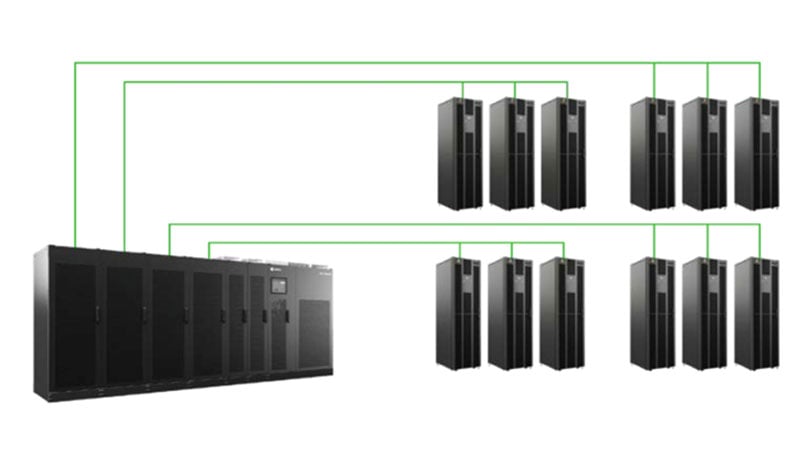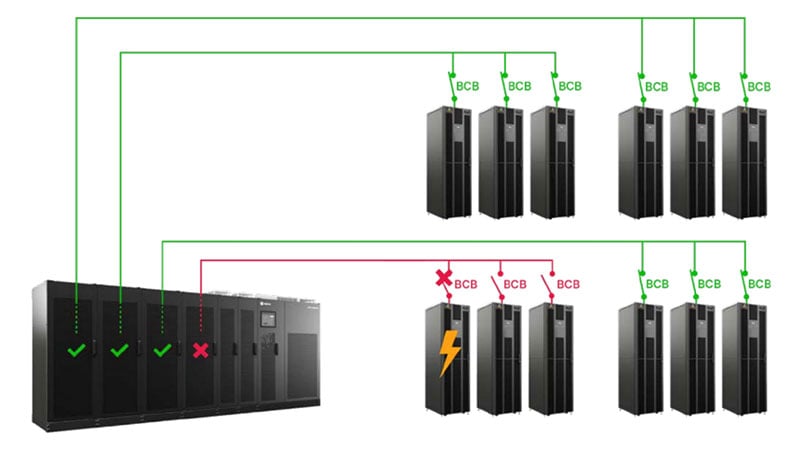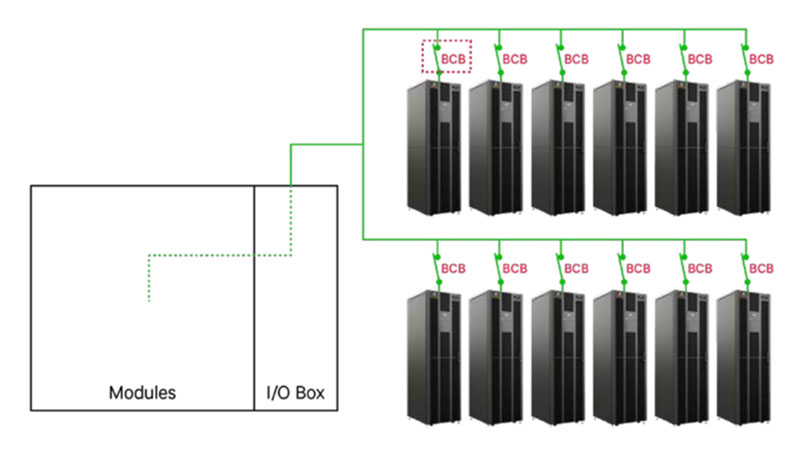In the context of escalating electricity consumption in data centers driven by the demands of AI and HPC, as highlighted in the 2023 UPS Analyst Call by Omdia, the role of uninterruptible power supplies (UPS) becomes increasingly significant. With major cloud service providers projected to increase their electricity usage by 50% this year alone, ensuring uninterrupted power becomes paramount.
In this landscape, UPS systems with distributed battery backup play a vital role in safeguarding industry operations by maintaining power quality, protecting electronic equipment from grid instability, and ensuring uninterrupted service for critical applications.
To fully grasp the importance and functionality of UPS systems with distributed batteries, delving deeper into their workings and benefits is essential. Learning how these systems operate and their profound impact on data center resilience reveals valuable insights into safeguarding operational continuity amidst rising energy demands and potential disruptions. Read on to explore the technology behind UPS with distributed batteries and its crucial role in powering the digital infrastructure of tomorrow.
Overview of UPS systems
Data center operators and owners usually choose from various UPS architectures for higher power systems applications, especially those running large-scale facilities. The type of UPS system is an essential factor for electrical energy battery backup configuration. These include monolithic and modular UPS systems.
Monolithic UPS system
A monolithic UPS offers satisfactory power protection to critical operations, functioning as a singular unit or within an integrated set of subsystems. While it can be part of parallel or dual-bus systems, it lacks internal redundancy and scalability for significant power shifts.
Modular UPS system
A modular UPS system consists of a frame filled with power modules that can be arranged based on capacity or redundancy. Each power module in a modular UPS functions independently, allowing for safe removal or installation even in a live system (known as "hot swapping" and "hot scaling").
The significance of battery integration in UPS reliability and infrastructure
Batteries play a vital role in power system function when the grid fails. They store electric energy during normal grid operations and offer backup power during outages. In data centers, they facilitate a seamless transition to long-term backup energy storage sources like generators, maintaining uninterrupted IT operations. Owners and operators choose from different UPS system support options with varying benefits and tradeoffs.
Centralized battery architecture
Centralized battery architecture in UPS systems connects all batteries to one point, offering simple installation and cost-effectiveness for primary components. However, it may lead to higher costs for ancillary devices like battery circuit breakers. While centralized systems have limitations in fault isolation, data center owners and operators can apply them on monolithic and modular UPS.

©2024 Vertiv Group Corp
Figure 1. An example of a centralized battery system with a monolithic UPS.
Distributed battery architecture
Distributed battery architecture uses a modular approach, pairing each power module with dedicated battery cabinets for enhanced load protection. Monolithic UPSs lack modularity and cannot work with distributed batteries in a single system. This architecture is only compatible with modular UPS systems. However, not all modular UPS support distributed battery setups due to DC power bar configuration limitations.

Vertiv™ Trinergy™ Cube modular UPS with distributed batteries ©2024 Vertiv Group Corp
Figure 2. An example of a distributed battery system with the Vertiv™ Trinergy™ Cube modular UPS and Vertiv™ EnergyCore lithium-ion battery cabinets which deliver 5 minute runtime up to 250 kW AC load reducing footprint.
Comparing system reliance of centralized and distributed battery configurations
Distributed batteries boost the advantages of a modular UPS system, while centralized batteries come with various tradeoffs to consider. Having a modular UPS system with distributed batteries offers numerous benefits, especially in terms of power interruptions between the battery circuit breaker (BCB) and UPS, battery failure isolation, electrical energy protection costs, and availability and reliability.
Short circuit BCB and UPS
Distributed battery systems are more efficient in the event of short circuits between the battery circuit breaker (BCB) and the UPS. This issue can arise from DC power cable insulation loss due to environmental factors, equipment issues, external interference, or aging infrastructure.
Power Disruption Risks in Centralized Battery Configurations
A short circuit between BCB and UPS in a centralized system can disrupt power, damage equipment, and cause downtime. Blown fuses on the DC/DC converter turn off UPS backup power in case of mains failure, compromising seamless battery backup transition.
Power System Resilience of Distributed Batteries
In contrast, the distributed battery setup is more resilient. Only the connected battery group is affected if a short circuit occurs between the BCB and the UPS, leaving the rest operational. This isolation prevents a system-wide shut down, ensuring continuous power supply to unaffected loads. Unlike centralized architectures with inherent vulnerabilities, distributed batteries enhance system availability and fault tolerance.
Battery failure isolation
UPS systems may face battery faults in different scenarios, posing challenges to the reliability and performance of the backup power infrastructure. Issues like insulation losses, short circuits, or malfunctions can occur. The UPS interfaces with the BCB to control trips for added safety.
Case 1: BCB can clear the fault
During a battery cabinet failure in a centralized battery system, the remaining batteries can still fully power the load if the BCB manages to isolate the fault. However, this redundancy is only for a shorter time due to reduced capacity with one less battery cabinet.
Conversely, the load continues to be supplied through batteries at full load in a distributed system during cabinet failure with fault isolation from the BCB. The impacted core initially draws energy from the remaining batteries and continues to provide full load with the remaining core in overload.
Case 2: BCB can't clear the fault
If the BCB can't clear the battery fault, distributed battery architectures offer better fault tolerance than centralized ones. In centralized setups, a single battery bank failure can spread through the DC power distribution, risking blown DC/DC converter fuses and loss of backup power. On the other hand, distributed batteries boost system resilience by isolating electrical connections. This limits failures within specific battery groups, preventing widespread outages.

Vertiv™ Trinergy™ Cube modular UPS with distributed batteries ©2024 Vertiv Group Corp
Figure 3. If the BCB cannot clear the battery fault, the fault will be localized within a single battery branch.
DC Power protection costs
In centralized power system setups, each BCB must handle the current of "N-1" strings or when the system continues to operate at total capacity, even with the failure of one string. During an internal short circuit in one string, all other battery strings will insist on supporting the failed one, which can overload the protection device. Global standards require power protection devices to be sized to ensure current interruption without rupture.
Increased battery cabinet numbers pose challenges in cost and component availability. For example, in a setup with four cabinets, BCBs should handle three cabinets' current, while in an eight-cabinet setup (see Fig. 4), they must manage seven cabinets' current. BCBs, often external, need sizing based on storage capacity requirements, leading to higher current rated BCBs and increased DC power protection costs.

Figure 4. In centralized battery setups, each BCB must be sized to withstand the current of N-1 strings (in this illustration, 11 strings). This results in higher costs for DC power protection.
Distributed energy storage architectures involve spreading battery modules across separate cabinets. As each BCB is only responsible for managing the current within its designated cabinet group, this configuration significantly reduces the current load and associated costs. While typically linked to higher costs, this is only sometimes the case when considering the overall solution cost.
Availability and system reliability
Distributed battery setups have maintenance advantages, particularly in BCB installation. A centralized battery system with one BCB for all batteries has a critical vulnerability - a single point of failure. This setup leads to all batteries being disconnected simultaneously by the breaker. Servicing or replacing batteries becomes difficult because any action on one battery cabinet affects all cabinets, preventing backup energy failure during maintenance.
Distributed battery setups offer improved serviceability and fault containment. Multiple battery strings enhance reliability by avoiding single points of failure, ensuring continuous power supply during faults. This system boosts power reliability, reduces interruptions, optimizes energy storage capacity, and cuts operating costs.
Installing Individual BCBs per Battery Cabinet or Group
Whether batteries are centralized or distributed, individual BCBs can be installed for each battery cabinet or group, eliminating single points of failure and disconnection. This minimizes downtime and enhances system availability but with higher costs. However, due to centralized logic, the UPS still can't control each BCB individually in centralized battery configurations and monolithic UPS systems.
Conclusion
Distributed battery systems offer robust solutions with improved fault tolerance, availability, and cost savings over centralized systems. They excel at isolating faults, ensuring uninterrupted power supply, and reducing risks of system-wide shutdowns. By managing battery modules across separate cabinets, these systems lower DC power protection costs and enhance efficiency, making them a compelling choice for reliable UPS infrastructure.
The Vertiv™ Trinergy™ Cube UPS is an example of technological innovation and operational excellence, standing at the forefront as the preferred modular UPS solution for businesses seeking unmatched reliability and scalability. It integrates with battery systems for uninterrupted power, control, and monitoring, ensuring resilience and efficiency. With Vertiv's support, this UPS safeguards critical operations and supports future growth with its dynamic modular design.
Whitepaper: Enhancing UPS reliability with the advantages of Distributed battery systems
Discover key insights on UPS resilience and efficiency in our whitepaper, "Improving UPS Reliability with Distributed Batteries." Learn about battery roles, redundancy, UPS system types, and battery architectures. Explore power system resilience in scenarios like short circuits and battery failures. Uncover cost factors in DC power protection and BCB setup for organizations seeking reliable power supply and cost efficiency.



